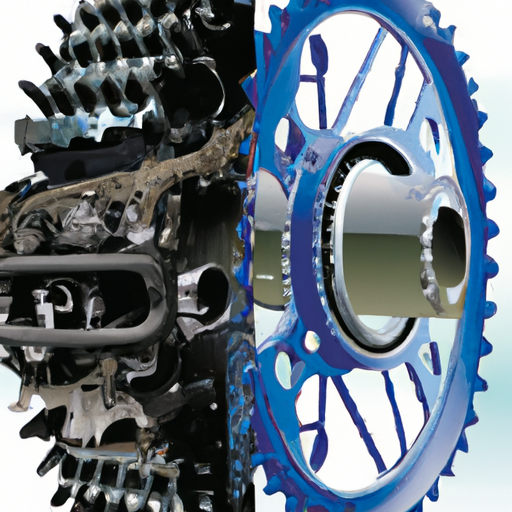You’ve probably heard of Trac-Lok and Truetrac, two popular differential options for off-road enthusiasts. But which one is the better choice for your vehicle? In this article, we’ll compare Trac-Lok and Truetrac, highlighting their key features, benefits, and limitations. By the end, you’ll have a clearer understanding of these two options, helping you make an informed decision when it comes to upgrading your vehicle’s differential. So let’s dive in and explore the differences between Trac-Lok and Truetrac!
1. Overview
1.1 What are Trac-Lok and Truetrac?
Trac-Lok and Truetrac are two types of limited-slip differentials commonly used in vehicles. Limited-slip differentials are designed to distribute torque evenly between the two wheels on an axle, providing improved traction in challenging driving conditions. Trac-Lok and Truetrac are both popular options for off-road enthusiasts and those looking for enhanced performance on various terrains.
Trac-Lok, also known as Trac-Lok Limited Slip Differential (LSD), is a mechanical system that uses a series of clutches to control the power distribution between the wheels. When one wheel begins to slip, the Trac-Lok differential engages the clutches, sending more torque to the wheel with better traction. This improves the vehicle’s ability to navigate through uneven surfaces, such as mud, gravel, or snow.
On the other hand, Truetrac is a helical gear-driven limited-slip differential. Instead of using clutches, it utilizes gears to transfer power to the wheel with better traction. This unique design allows for full driveline differentiation when needed, resulting in smoother engagement and improved handling. Truetrac is often favored for its quiet operation and superior performance in a wide range of driving conditions.
1.2 Purpose of the Comparison
The purpose of this comparison is to provide you with a comprehensive understanding of the differences and similarities between Trac-Lok and Truetrac differentials. By examining their functionality, traction control mechanisms, performance on different terrains, availability, compatibility, installation process, maintenance requirements, and cost, you will be able to assess which option best suits your specific needs and preferences.
2. Functionality
2.1 How Trac-Lok Works
Trac-Lok operates by utilizing a set of clutches to regulate the torque distribution between the two wheels on an axle. When one wheel slips, typically due to a lack of traction, the Trac-Lok differential engages the clutches. This causes more torque to be transferred to the wheel with better traction, allowing the vehicle to maintain forward momentum. The clutches are designed to limit the slip to a certain predetermined level, providing a balance between improved traction and ride comfort.
2.2 How Truetrac Works
Truetrac, unlike Trac-Lok, employs a helical gear design to distribute power between the wheels. The gear-driven mechanism permits a varying amount of torque to be transmitted to each wheel, depending on the available traction. This intelligent design ensures that power is delivered to the wheel with the best grip, improving overall traction and handling. The operation of Truetrac is seamless and mechanical, without the need for clutches or friction plates.

3. Differential Type
3.1 Type of Differential for Trac-Lok
Trac-Lok is a limited-slip differential (LSD). Limited-slip differentials are designed to distribute torque between the wheels, rather than allowing one wheel to spin freely while the other remains stationary. The clutch-based system employed by Trac-Lok offers a predetermined amount of slippage before engaging, providing improved traction while maintaining drivability.
3.2 Type of Differential for Truetrac
Truetrac is also a limited-slip differential (LSD), but it utilizes a helical gear design instead of clutches. The gear-driven mechanism provides a smooth and continuous transfer of torque between the wheels, allowing for greater traction and control. This unique design makes Truetrac particularly well-suited for various terrains and driving conditions.
4. Traction Control
4.1 Traction Control Mechanism in Trac-Lok
In Trac-Lok differentials, the primary mechanism for controlling traction is through the use of clutches. When slippage occurs, the clutches engage, transferring torque to the wheel with better traction. The design of Trac-Lok allows for some degree of slip before it applies the clutches, ensuring a comfortable driving experience while still providing improved traction.
4.2 Traction Control Mechanism in Truetrac
Truetrac differentials utilize the helical gear design to maintain traction control. The gear-driven mechanism ensures that power is distributed to the wheel with better grip, utilizing the available traction effectively. This results in enhanced overall control and stability, as the differential automatically adapts to the varying driving conditions and traction requirements.

5. Performance on Different Terrains
5.1 Off-Road Performance
When it comes to off-road performance, both Trac-Lok and Truetrac differentials offer significant advantages. Trac-Lok’s clutch-based system provides an excellent balance between improved traction and drivability. It excels in muddy, snowy, or gravelly terrains where wheel slippage is common. The ability of Trac-Lok to transfer torque to the wheel with better traction ensures that your vehicle can power through challenging off-road conditions.
Truetrac, with its gear-driven design, also delivers impressive off-road performance. The smooth and seamless transfer of power between the wheels allows for better traction and control on uneven terrains. The differential’s responsiveness to changing traction conditions ensures maximum traction when navigating rocky or uneven surfaces.
5.2 On-Road Performance
Both Trac-Lok and Truetrac differentials offer improved on-road performance compared to open differentials. Trac-Lok provides enhanced traction on slippery or wet roads, reducing the likelihood of wheel spin and improving overall stability. It is especially beneficial for vehicles that often encounter changing road conditions, such as those driven in regions with frequent rain or snow.
Truetrac also performs admirably on paved surfaces. Its gear-driven mechanism allows for smooth and seamless power transfer between the wheels, resulting in improved handling and stability. Truetrac’s ability to adapt to different driving conditions makes it an excellent choice for drivers seeking enhanced on-road performance without sacrificing off-road capability.
6. Availability and Compatibility
6.1 Availability of Trac-Lok
Trac-Lok differentials are widely available for a wide range of vehicle models and axle configurations. They can be purchased from various automotive parts retailers and specialty shops. It is essential to verify the compatibility of Trac-Lok with your specific vehicle make, model, and axle type before making a purchase.
6.2 Availability of Truetrac
Similar to Trac-Lok, Truetrac differentials are readily accessible in the market. They are available for numerous vehicle models and axle configurations. Various retailers and off-road specialty stores offer Truetrac differentials. As with any aftermarket differential, it is crucial to confirm compatibility with your vehicle before making a purchase.
6.3 Compatibility with Different Vehicle Models
Both Trac-Lok and Truetrac differentials are compatible with a wide range of vehicle models, including trucks, SUVs, and 4×4 vehicles. However, it is crucial to verify compatibility with your specific vehicle before purchasing a differential. Factors such as axle type, gear ratio, and manufacturer specifications need to be considered to ensure a proper fit and functionality.

7. Installation and Maintenance
7.1 Installation Process for Trac-Lok
Installing a Trac-Lok differential typically requires specialized knowledge and tools. It is strongly recommended to consult a professional mechanic or an experienced automotive technician for the installation process. The differential must be correctly positioned and aligned to ensure optimal performance and longevity.
7.2 Installation Process for Truetrac
The installation process for a Truetrac limited-slip differential is similar to that of Trac-Lok. It is a complex procedure that involves the removal of the existing differential and the installation of the Truetrac unit. Due to the technical nature of the installation, it is advisable to seek professional assistance to ensure a proper fit and functionality.
7.3 Maintenance Requirements
Both Trac-Lok and Truetrac differentials require regular maintenance to ensure optimal performance and longevity. It is essential to follow the manufacturer’s guidelines regarding fluid changes and inspections. Regular inspection of the clutches, gears, and internal components is necessary to identify any signs of wear or damage. Any issues should be addressed promptly to prevent further damage.
8. Cost Comparison
8.1 Price of Trac-Lok
The price of a Trac-Lok differential can vary depending on the specific vehicle model and axle configuration. On average, a Trac-Lok differential can range from $500 to $800, excluding installation costs. It is essential to consider additional expenses, such as installation and any required modifications, when determining the overall cost.
8.2 Price of Truetrac
The cost of a Truetrac differential is generally comparable to that of a Trac-Lok differential. Prices typically range from $500 to $900, excluding installation costs. As with Trac-Lok, additional expenses, such as installation and any necessary modifications, should be taken into account when evaluating the overall cost.
8.3 Long-Term Cost Considerations
When comparing the long-term costs of Trac-Lok and Truetrac, it is crucial to consider factors such as maintenance requirements, replacement parts availability, and durability. Truetrac, with its gear-driven design, generally requires less maintenance compared to Trac-Lok’s clutch-based system. The availability of replacement parts may also affect long-term costs, with Trac-Lok being a more widely used differential and potentially offering additional cost savings.

9. User Reviews and Ratings
9.1 Trac-Lok User Reviews
Trac-Lok differentials have received positive reviews from users who have utilized them in various off-road and on-road conditions. Many appreciate the improved traction provided by Trac-Lok in challenging terrains, while others praise its reliability and longevity. However, some users have reported occasional maintenance issues, such as clutch wear, which may require replacement over time.
9.2 Truetrac User Reviews
Truetrac differentials have also garnered favorable reviews from users, especially those looking for a robust and reliable limited-slip differential. Many users commend Truetrac for its seamless operation, enhanced traction, and quiet performance. The durability and minimal maintenance requirements of Truetrac are often highlighted as significant advantages by users.
9.3 Expert Ratings
Experts in the automotive industry generally regard both Trac-Lok and Truetrac differentials positively. The specific benefits and performance characteristics of each differential are recognized, and experts often emphasize the suitability of Trac-Lok for more demanding off-road conditions, while noting the overall versatility and adaptability of Truetrac.
10. Conclusion
10.1 Factors to Consider
When deciding between Trac-Lok and Truetrac differentials, several factors should be considered. These include the specific driving conditions and terrains you encounter, the desired level of traction control, the availability and compatibility with your vehicle, the installation process, maintenance requirements, and the overall cost, both upfront and long-term.
10.2 Final Verdict
Ultimately, the choice between Trac-Lok and Truetrac differentials depends on your particular needs and preferences. Trac-Lok is generally recommended for those seeking enhanced traction control in extreme off-road conditions, while Truetrac offers excellent all-around performance and reliability. Consult with automotive experts and consider user reviews to determine which differential best suits your driving style and vehicle requirements.

